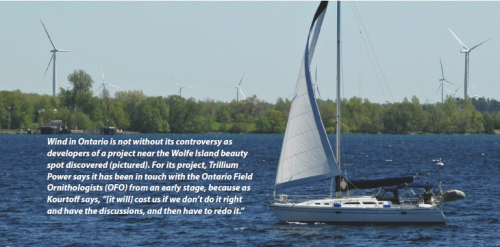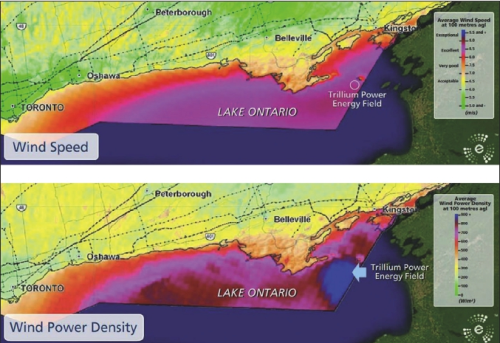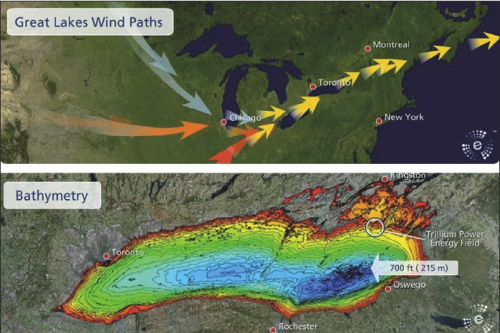


Trillium Power, the privately owned wind power developer based in Toronto, Ontario, Canada, is gearing up to develop what could be North America’s first offshore wind farm, albeit in freshwater rather than the salty sea.
Location, Location, Location
According to Kourtoff, location is key for its four proposed offshore wind farms on Lake Ontario – part of the Great Lakes, which are split between the USA and Canada.
When it came to selecting potential sites on Lake Ontario, Trillium Power looked at avian, aquatic, bathymetry, transmission, visual aesthetics, ice, etc. and scaled each criterion before choosing sites with high score for each point. This led Trillium Power to four sites on the Ontario side of the Great Lakes, and a few on the US side. The USA does not offer feed-in tariffs (FiTs) or regulatory certainty, and so they decided to build in Ontario where they know the regulatory framework.
The Ontario side of the Great Lakes has strong, consistent wind. The winds usually come from the west towards the east, so they generally come towards the Ontario side, which means the winds have picked up strength before hitting potential wind farms. “The Lake has this funnel effect. There’s this unique spot (Trillium Power Energy Field) that has a very high power density – we should have about 600-650 W/m2 based on wind speed alone and instead we have 938 W/m2,” Kourtoff says.
Furthermore: “We have no tides, no salt water. So we have all the bits you want, without the bits you don’t want.” Despite the lake being fresh water, it rarely ices over. “Given climate change and human habitat destruction it’ll be a seaside resort before it’s ever going to ice over,” Kourtoff jests.
Ontario also has the advantage of potentially being able to transport energy to the 95 million people living around the Great Lakes. It connects to 8 US states directly, and indirectly Ontario power could reach an additional 20 US states – about 126.5 million people in total. “So Ontario will be this major electron provider, renewables are its way for the future.”
Regulatory Certainty
One of the reasons why Ontario has proven such a good location for Trillium Power’s projects is that they have a guaranteed 6 month timeframe for regulatory and permitting processes.
A Great Lakes Anecdote |
|
As part of the pre-construction wind monitoring using LiDAR and a Metmast, Trillium Power set up solar panels and some micro wind turbines on the Metmast to power measurement equipment. The wind turbines are about 1 m in diameter and 15 ft up from the ground. “Well… the first ones exploded because the winds are so consistent and powerful. The second ones exploded, so we’re now on our third set, and you’d think that these would last as they are supposed to go in places which are pretty windy, but people don’t realize the power and consistency of the winds out there,” Kourtoff tells Renewable Energy Focus U.S. |
“At the end of the 6 months, people could object – they have a 15 day window, but the window says that you have to object within the time period. You have to have done your own studies that you pay for and that have to be peer reviewable. They have to prove that a renewable energy project will – not might, not may – but will cause permanent and irrevocable harm, which gets rid of all the frivolous issues, where people hide themselves from saying that they don’t like the visual aesthetic, and saying that there’s some environmental thing, and cloak themselves in that.”
Furthermore, instead of trying to twist existing permitting rules into fitting the renewable energy business, Ontario started with a blank page. “They started from feed-in tariffs, they went and consulted industry, they brought in experts, and they did this in a very, very small time window. It was an incredible amount of work that was done very well.”
“The Government of Ontario has been very supportive and yet very even handed so far. The Ministry of Economic Development has assisted us with overseas contacts through the highly-trained people they have in various jurisdictions, [but] they haven’t put any money into us either directly or indirectly.”
He says Trillium Power is conducting a final development stage financing through its advisors, Dundee Capital Management, but Kourtoff believes early-stage funding is critical for newcomers. “If you’re a small developer, you can do small projects, but if you’re a small developer starting, and you want to build a big project, you have to have a balance sheet.”
However, he believes Ontario’s policies are right for the wind power business: “They have correctly understood that if you provide the certainty of a feed-in tariff, people will come and they’re coming even in spite of not having financial handouts.”
The Finances
Unlike the UK Round 3, which is mainly led by large consortia, Ontario offshore wind developers have had generally had to fly solo.
“We’ve had our own capital in it since the beginning,” Kourtoff says. “My wife is from northern Germany, and they say that, from her part of Germany, they’re so good at stretching a penny, it becomes wire. The Scots tell me that they invented that, but I think we’ve perfected it at Trillium Power because we’ve never had a penny from either the Federal, or the Provincial Government.
“We haven’t had the big balance sheets, and yet, where we’ve gotten to, is stage 14 of the 15 stages to development for offshore… The next stage is construction,” Kourtoff tells Renewable Energy Focus U.S.
“We’ve had our back to the wall – I don’t know how many times. We’ve had moratoria, global financial meltdowns and just about everything else thrown at us. We have become stronger and smarter because of it. It’s mostly been just financial challenges, capital raising at one point or another, but thankfully every time we’ve had the money come in. We’ve had the people that understood the value of the proposition.” Most of Trillium Power’s private investors are from Canada and Europe. Construction equity interest has come from Europe, the Middle East, the United States, Asia – and recently from Canada.
Earlier this year, Trillium Power estimated the development of its four proposed sites would require a private sector investment of C$14.8 billion over a 10-12 year period.
Kourtoff acknowledges that state and regional budgets can be tight, and that it can be tough to keep supporting renewable energy, which is perceived to be more expensive. “But they don’t see the real cost of fossil fuel and nuclear,” he warns. He goes on to call nuclear projects “weapons of financial destruction” as they never come on time, nor on budget.
TPW1 Project Quick Facts |
Three more projects planned:
|
“For renewables, we’ve got a challenge because the [economic] meltdown has created some major issues,” Kourtoff says. In Canada, the financial resources are there with the banks, which were not as hard hit by the economic recession as in many other places. But Kourtoff says the banks need a wake-up call: “It’ll probably take some prodding where they have their lunch-money stolen by some of the European, American, Middle Eastern or Asian banks before they’ll [get involved].”
Trillium Power Wind 1
For its first project, Trillium Power Wind 1 (TPW1), Trillium is ready for the construction phase. “We’ve just finished our AWAC, which is our Acoustic Water and Current Levels.” As there has been a lighthouse at Main Duck Island in Lake Ontario, Trillium Power has about 50 years’ worth of wind data including nearly 18 months from a side-by side LiDAR and 80 m Metmast. “We’ve got more wind data than any other place that we know of off shore,” Kourtoff says.
Local Wildlife
“The Ontario Government’s own studies showed that we would regenerate the aquatic species at eight times the normal speed, so it’s actually positive for the aquatic, and while we are still conducting avian studies so far we have not found any major migratory flyways.”
Trillium Power has also been in touch with the Ontario Field Ornithologists (OFO) from an early stage, because as Kourtoff says, “[it will] cost us if we don’t do it right and have the discussions, and then have to redo it.”
The Perfect Partner
Trillium Power is already in discussions with several potential partners for its projects, one of which is Vestas (the others are non-disclosures), Kourtoff says. “We are working very closely with Vestas. They approached us with an idea of how to build an industry. We are trying to see how our systems can work together.”
Trillium Power looked at Vestas three or four years ago, but nothing came out of it. However, there has since been “a phenomenal change” in Vestas, according to Kourtoff. “Their North American Off shore Wind team, based in Toronto, has been phenomenal to work with. They’ve come with open arms and brought engineering resources, and projected management resources; introduced us to people in cabling, etc. however we have not closed the door to any turbine options at this time.”
Vestas may be asked to become involved in project management. In addition, Trillium Power is currently getting cabling, owner’s engineers, etc. into place before submitting the final studies for permitting.
The Foundations
Trillium Power has not yet decided on what type of foundation structures to use for TPW1: “We’re looking at monopile and we’re looking at gravity- based, but in a different way, because Trillium Power Wind 1 is directly on bedrock – limestone and shale. So we have a unique opportunity of being able to drill it down, and put the tower and the foundations directly in the rock.”
Trillium Power is also looking to construct Great Lakes specific foundations that use local steel and other materials. “We’re adapting everything for the North American and the Great Lakes market.”
“Once we have the permitting finalization – say Q1/Q2 next year; we’ll have financial close late Q2 – maybe into Q3 – and then at then at that point we officially start construction. … We wouldn’t be going into the water maybe until Q4 of 2012 or 2013, and then going all the way through 2013.”
Ontario Benefits |
|
Using a Haywood Securities Base Model, full offshore wind deployment on the Ontario side of the Great Lakes could generate a total of C$253.6 billion in gross economic activity over 15 years, assuming an average development cost of C$4m/MW. One year of gross economic activity from offshore wind development would be equivalent to roughly 3% of Ontario’s and 1% of Canada’s entire gross domestic project (GDP). It would also add C$7.6bn in annual tax revenues to the provincial treasury and the sale of emission credits from offshore wind alone could add a further C$3.6bn to the provincial treasury per year. Trillium Power estimates that full deployment of Ontario’s Reserved Offshore Potential would create 66,000 jobs. |
The US Cape Wind project has received a lot of media attention compared to Trillium Power’s Great Lakes projects, despite being ahead in the game. “Jim Gordon, who I know and respect at Cape Wind, was flabbergasted [when we first talked], because he thought he was early [having been on the project] 7 or 8 years. We’ve been at it for 15 years, so he’s ‘Johnny-come-lately’ compared to us. But he’s had far more notoriety and undeserved difficulty, which we don’t want, because of all the push back and legal problems that he’s had. We wish him the best success.”
The US offshore Cape Wind project has already been reduced from 170 wind turbines to 130.
A Social Responsibility
There is also a social responsibility when developing large projects. “Are you just trying to make a financial gain, and walk away and say: ‘Well, I’ve got mine, to hell with you?’,” Kourtoff asks. “Or are you going out there and saying: ‘We have a responsibility to provide as many jobs and economic benefits as possible.’ I don’t just mean exclusively Ontario, but within the supply chain.”
One clear example of Trillium Power’s sense of social responsibility is its cooperation with the First Nations. “One of the principles that Trillium Power started with, is that we don’t discriminate. Number two is, we give people who are local, chances locally.”
Kourtoff adds: “In the case of the First Nations – what people don’t realize is that the First Nations, especially the Mohawks and Cherokees have a unique ability on high steel, so that’s how they built all the buildings in New York, Montreal and big bridges. They can eat a sandwich and walk on a beam four inches wide and not get vertigo and be up 200 ft in the air. The rest of us would be hugging the steel beam for dear life.
“We reached out to them, and they’ve been phenomenally supportive.”
Trillium Power is perhaps not as well known as some of the European offshore wind developers, but they are certainly breaking many ‘firsts’ with their Great Lakes offshore wind farm projects.
As Kourtoff says: “Wayne Gretzky is very famous as a Canadian hockey player, and his father, Walter Gretzky, is alleged to have said to him: ‘Don’t go where the puck is, go where it’s going to be.’ And so what we did, long before there’s even onshore wind, we went in this other direction. Everyone said, you guys are nutters, but now the puck comes around the other side, and now suddenly we’re savants. First we’re idiots – now we’re savants.”
Renewable Energy Focus U.S. Issue 2, September/October 2010, p20-23.




